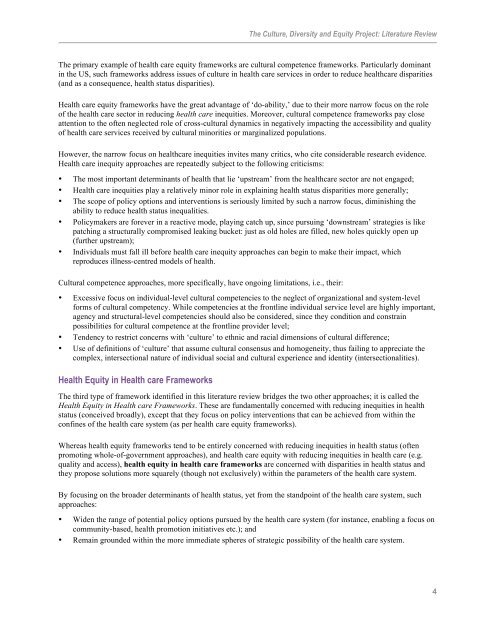CDE Appendix 1 Literature Review - Central East Local Health ...
CDE Appendix 1 Literature Review - Central East Local Health ...
CDE Appendix 1 Literature Review - Central East Local Health ...
You also want an ePaper? Increase the reach of your titles
YUMPU automatically turns print PDFs into web optimized ePapers that Google loves.
The Culture, Diversity and Equity Project: <strong>Literature</strong> <strong>Review</strong><br />
The primary example of health care equity frameworks are cultural competence frameworks. Particularly dominant<br />
in the US, such frameworks address issues of culture in health care services in order to reduce healthcare disparities<br />
(and as a consequence, health status disparities).<br />
<strong>Health</strong> care equity frameworks have the great advantage of ‘do-ability,’ due to their more narrow focus on the role<br />
of the health care sector in reducing health care inequities. Moreover, cultural competence frameworks pay close<br />
attention to the often neglected role of cross-cultural dynamics in negatively impacting the accessibility and quality<br />
of health care services received by cultural minorities or marginalized populations.<br />
However, the narrow focus on healthcare inequities invites many critics, who cite considerable research evidence.<br />
<strong>Health</strong> care inequity approaches are repeatedly subject to the following criticisms:<br />
• The most important determinants of health that lie ‘upstream’ from the healthcare sector are not engaged;<br />
• <strong>Health</strong> care inequities play a relatively minor role in explaining health status disparities more generally;<br />
• The scope of policy options and interventions is seriously limited by such a narrow focus, diminishing the<br />
ability to reduce health status inequalities.<br />
• Policymakers are forever in a reactive mode, playing catch up, since pursuing ‘downstream’ strategies is like<br />
patching a structurally compromised leaking bucket: just as old holes are filled, new holes quickly open up<br />
(further upstream);<br />
• Individuals must fall ill before health care inequity approaches can begin to make their impact, which<br />
reproduces illness-centred models of health.<br />
Cultural competence approaches, more specifically, have ongoing limitations, i.e., their:<br />
• Excessive focus on individual-level cultural competencies to the neglect of organizational and system-level<br />
forms of cultural competency. While competencies at the frontline individual service level are highly important,<br />
agency and structural-level competencies should also be considered, since they condition and constrain<br />
possibilities for cultural competence at the frontline provider level;<br />
• Tendency to restrict concerns with ‘culture’ to ethnic and racial dimensions of cultural difference;<br />
• Use of definitions of ‘culture’ that assume cultural consensus and homogeneity, thus failing to appreciate the<br />
complex, intersectional nature of individual social and cultural experience and identity (intersectionalities).<br />
<strong>Health</strong> Equity in <strong>Health</strong> care Frameworks<br />
The third type of framework identified in this literature review bridges the two other approaches; it is called the<br />
<strong>Health</strong> Equity in <strong>Health</strong> care Frameworks. These are fundamentally concerned with reducing inequities in health<br />
status (conceived broadly), except that they focus on policy interventions that can be achieved from within the<br />
confines of the health care system (as per health care equity frameworks).<br />
Whereas health equity frameworks tend to be entirely concerned with reducing inequities in health status (often<br />
promoting whole-of-government approaches), and health care equity with reducing inequities in health care (e.g.<br />
quality and access), health equity in health care frameworks are concerned with disparities in health status and<br />
they propose solutions more squarely (though not exclusively) within the parameters of the health care system.<br />
By focusing on the broader determinants of health status, yet from the standpoint of the health care system, such<br />
approaches:<br />
• Widen the range of potential policy options pursued by the health care system (for instance, enabling a focus on<br />
community-based, health promotion initiatives etc.); and<br />
• Remain grounded within the more immediate spheres of strategic possibility of the health care system.<br />
4

















